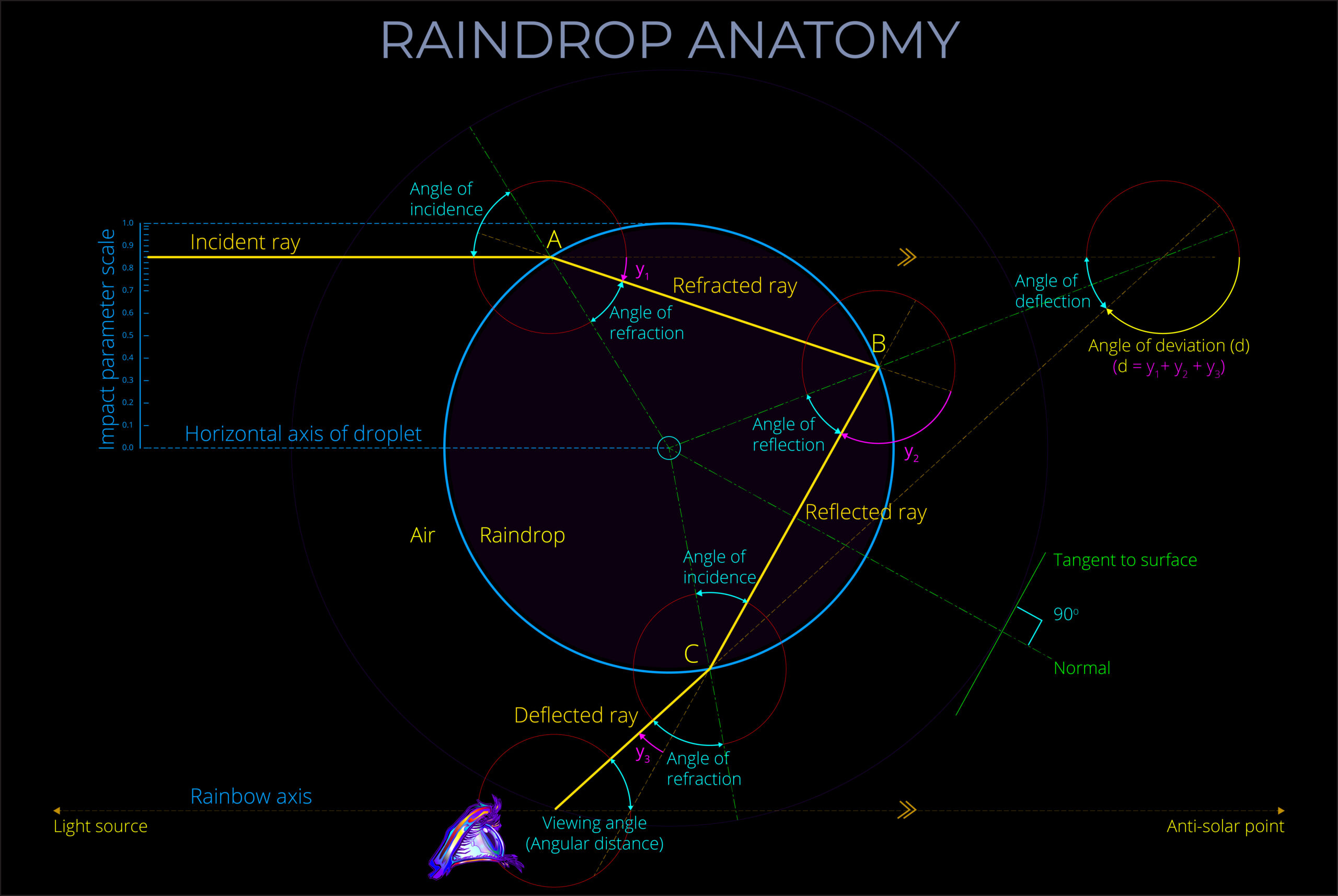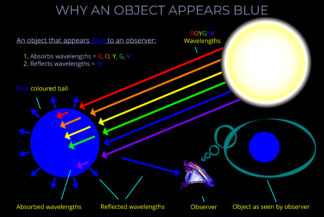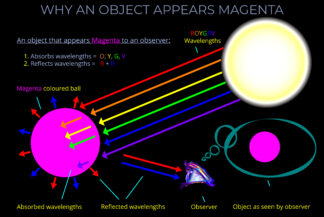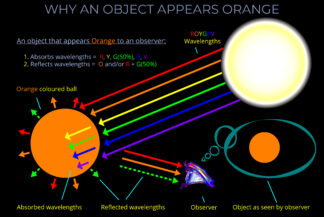Raindrop Anatomy
£0.00
This is one of a set of almost 40 diagrams exploring Rainbows.
Each diagram appears on a separate page and is supported by a full explanation.
- Follow the links embedded in the text for definitions of all the key terms.
- For quick reference don’t miss the summaries of key terms further down each page.
Description
Raindrop Anatomy
TRY SOME QUICK QUESTIONS AND ANSWERS TO GET STARTED
About the diagram
Overview of the diagram
- This diagram aims to identify a simple and closely interconnected set of terms that explain how individual raindrops form rainbows.
- The terms used here underpin our Introduction to Rainbows and our resource Rainbows: In detail.
- A quick internet search will reveal that the way terms are defined and used varies. We have made every effort to align ourselves with research that provides an accessible and straightforward introduction to rainbows.
About the diagram
- The diagram shows some of the geometry that determines the path of light through a raindrop.
- This is a measured diagram and the angles shown are indicative of the path of a single yellow ray with a wavelength of 589.29nm travelling through water at 200C.
- The table below provides a key to the notation used on the diagram.
- Beyond identifying a simple and closely interconnected set of terms, the aim of the diagram is to:
- highlight the geometric points used to explain changes in the direction and speed of light when it strikes the surface of a raindrop.
- Show where and how angles are measured.
- Show connections between angles.
- Note that:
- The notation used in the diagram is not associated with any other system of identification.
- Standard mathematical symbols have not been used for this diagram.
| Label | Description |
|---|---|
| Air | Earth's atmosphere is generally considered to be composed of nitrogen, oxygen, argon with trace amounts of carbon dioxide, hydrogen, methane and neon. Average humidity, pressure and a temperature of 20C produce a refractive index of 1.000293. |
| Raindrop | An idealised raindrop forms a geometrically perfect sphere. Although such a form is one in a million in real-life, simplified geometrical raindrops help to make sense of rainbows and reveal general rules governing why they appear. |
| Impact parameter scale | An impact parameter scale is used on a ray-tracing diagram to measure the point at which incident rays strike the surface of a raindrop. Rays are given a value between 0.0 and 1.0 depending upon their point of impact. |
| Horizontal axis of a raindrop | The horizontal axis of a raindrop is usually drawn on a ray diagram (showing the Sun, observer and anti-solar point in side-elevation) as running parallel with incident rays and the rainbow axis. |
| Light source | A light source is a natural or man-made object that emits one or more wavelengths of light. |
| Anti-solar point | The point on the rainbow axis around which a rainbow appears is called the anti-solar point. The centre of a rainbow coincides with the anti-solar point. |
| A | The point at which an incident ray strikes a raindrop |
| B | The point at which a refracted ray is reflected off the inside of a raindrop. |
| C | The point at which a reflected ray strikes the inside of a raindrop undergoes refraction and exits towards an observer. |
| Incident ray | Incident ray refers to incoming light that is travelling towards an object or medium |
| Refracted ray | A refracted ray is a ray that has undergone refraction. |
| Reflected ray | A reflected ray is a ray that has undergone reflection. |
| Deflected ray | A deflected ray is a ray that has been deflected from its original path in the direction of an observer. |
| Angle of incidence | The angle of incidence measures the angle at which incoming light strikes a surface. |
| Angle of refraction | The angle of refraction measures the angle to which light bends as it passes across the boundary between different media. |
| Angle of reflection | The angle of reflection measures the angle at which reflected light bounces off a surface. |
| Angle of deflection (d) | The angle of deviation measures the degree to which the path of a light ray is bent back by a raindrop in the course of refraction and reflection towards an observer. |
| Angle of deviation | The angle of deviation measures the degree to which the path of a light ray is bent back by a raindrop in the course of refraction and reflection towards an observer. |
| Angular distance | Angular distance is the angle between the rainbow axis and the direction in which an observer must look to see a specific colour within the arcs of a rainbow. |
| Viewing angle | The viewing angle of a rainbow is the angle between a line extended from an observer’s eyes to a bow’s centre point and a second line extended out towards the coloured arcs. |
| y1 | The angle of deviation at point A |
| y2 | The angle of deviation at point B |
| y3 | The angle of deviation at point C |
| y1 + y2 + y3 = | The total angle of deviation |
| Tangent to surface | A tangent to a circle is a straight line that touches but does not intersect the circle and is at right angles to a radial line drawn from the centre of the circle. |
| Normal | If one line is normal to another, then it is at right angles. In geometry, the normal (or a normal) refers to a line drawn perpendicular to and intersecting another line, plane or surface. |
| >> | The symbol used to mark parallel lines. |
Key to Rainbow Anatomy diagram
Some key terms
The angle of reflection measures the angle at which reflected light bounces off a surface.
- The angle of reflection is measured between a ray of light which has been reflected off a surface and an imaginary line called the normal.
- See this diagram for an explanation: Reflection of a ray of light
- In optics, the normal is a line drawn on a ray diagram perpendicular to, so at a right angle to (900), the boundary between two media.
- If the boundary between the media is curved then the normal is drawn perpendicular to the boundary.
When discussing rainbows, angular distance is the angle between the line from the observer to the centre of the rainbow (rainbow axis) and the line from the observer to a specific colour within the arc of a rainbow.
- See this diagram for an explanation: Angular distance & Raindrop colour
- Angular distance is one of the angles measured on a ray-tracing diagram that illustrates the sun, an observer, and a rainbow from a side view.
- Think of angular distance as the angle between the line to the centre of a rainbow down which an observer looks and the line to a specific colour in its arc. The red light is deviated by about 42.4° and violet light by about 40.7°.
The angle of refraction measures the angle to which light bends as it passes across the boundary between different media.
- The angle of refraction is measured between a ray of light and an imaginary line called the normal.
- In optics, the normal is a line drawn on a ray diagram perpendicular to, so at a right angle to (900), the boundary between two media.
- See this diagram for an explanation: Refraction of a ray of light
- If the boundary between the media is curved, the normal is drawn perpendicular to the boundary.
The angle of incidence measures the angle at which incoming light strikes a surface.
- The angle of incidence is measured between a ray of incoming light and an imaginary line called the normal.
- See this diagram for an explanation: Reflection of a ray of light
- In optics, the normal is a line drawn on a ray diagram perpendicular to, so at a right angle to (900), the boundary between two media.
- If the boundary between the media is curved, then the normal is drawn at a tangent to the boundary.
An artificial light source is any source of light created by humans, as opposed to natural light sources like the sun or stars. Artificial light sources are generated by converting different forms of energy into light.
- There are several major categories of artificial light sources such as:
- Incandescent: These work by heating a filament until it glows, emitting light (traditional light bulbs).
- Fluorescent: Electric current triggers gas inside the bulb to produce ultraviolet light, which a phosphor coating converts into visible light.
- LED (Light-Emitting Diode): Electricity excites semiconductors, causing them to emit light.
- Gas-discharge lamps: Electric current passes through a gas, producing bright light (e.g., neon signs, street lamps).
When discussing the formation of rainbows, the angle of deflection measures the angle between the initial path of a light ray before it hits a raindrop, and the angle of deviation, which measures how much the ray bends back on itself in the course of refraction and reflection towards an observer.
- See this diagram for an explanation: Rainbow anatomy
- The angle of deflection and the angle of deviation are always directly related to one another and together add up to 180 degrees.
- The angle of deflection equals 180 degrees minus the angle of deviation. So, it’s clear the angle of deviation is always equal to 180 degrees minus the angle of deflection.
- In any particular case, the angle of deflection is always the same as the viewing angle because the incident rays of light that form a rainbow all follow paths that run parallel with the rainbow axis.



